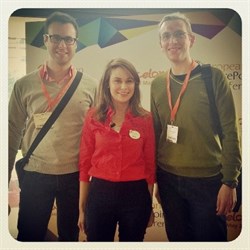Second day of the conference and this day was about “social”. How can help SharePoint you and your company to get social.
The keynote was presented by Christian Buckley and Mark Kashman. They want tomake “social successful”.

Christian Buckley and Mark Kashman
We, employees, want to stay connected and use multiple tools to achieve this. When we talk about enterprise social we see that is all about management and leadership, not technology. You can’t just deploy the technology and walk away and hope that it will work. That is not the way it works.
It is about giving people a voice who had no voice in your organization before. You and the organization need to be ready for that.
The 3 main components of a good social strategy are:people, process and technology.
The more you feed your social network the more information you get out of it.
The following session was development related. Wouter van Vugt was telling us more about the mistakes every developer will make while developing SharePoint applications.
When you are a SharePoint developer you get into these stages :
- Denial
- Disbelieve
- Anger
- Enjoyment
In what stage are you now?
Wouter listed some common mistakes and tips:
- Use SharePoint for something it is not build for, it is not a relational database
- SharePoint is designed for intranet solutions, be careful when you use it for public facing websites. Prevent that users can access unwanted pages.
- Beware of the fact that you content will grow. For example: queries can (by default) not return more than 5000 items.
- Not locking down. Know that by default the content is editable in SharePoint. Users can and will delete columns or change the name of the list.
- Do not use the title of items to access it. Use the GUID.
- Do not put you data always in lists. Sometimes it is far better to store it in a relational database like SQL Server.
- When you use webparts, users can delete them from the page. To prevent that you could use application pages
- Try to build as much as you can declarative. Avoid writing code for things that you can declare (and you can declare a lot!)
- Never underestimate the complexity of the SharePoint API.
- Do not think that you development environment is the same as you production environment. Use tools like ManageFusion Mod Rewriter to simulate the production environment.
- It is not all about the sessions here at the conference. You get the chance to meet companies and interesting people. While walking in the exposition area I’ve spoken to:
- Nintex, who’s having one of the best workflow engines that you can find on SharePoint and SharePoint Online
- Foxit, a company that does some interesting things with PDF documents
- LightningTools, has some great tools to enhance your SharePoint UI
- Qumu, a company that let you do great things with video on your SharePoint environment
- HiSoftware, great stuff about security and compliance
- MetaLogix, MetaVis, AvePoint, … and a lot more
The last years the number of vendors grew by more than 100% I guess. Impressive how good all their solutions are.
Another session was abouthow you can build solutions that are cloud ready. Developing SharePoint app or cloud solutions can be a bumpy ride.
The “SharePointContext” class is a good helper when you are developing hybrid solutions on SharePoint. The more samples Marek showed us the more I get the feeling that he was really hacking through the SharePoint API.
Do you want more samples about working with the app model then you need to check the link in this tweet from Jeremy Thake:
Jeremy Thake @jthake: In @marekCzarzbon session on using App Model on-prem building Intranets w/ site provisoining etc. #espc14 check out bit.ly/1jdm2Ky
I also attended a session aboutcodename Oslo and Office Graph.The whole Oslo and social story sounds interesting but I don’t know a lot of companies that are actually using it. It seems like it has to do with the company culture. The more ‘open’ the culture the more interesting Oslo can be. Oslo is based on SharePoint search and give you can continuous stream of information based on your profile. This was the least interesting session I attended so far. Too bad because the level of information this year is really high.
To end the day there was a session about developing SharePoint solutions with CoffeeScriptby Thorsten Hans. I’ve never heard of CoffeeScript before so it was all new for me. CoffeeScript is a programming language thatcompiles into JavaScript. You can compare it with TypeScript. It is easier to write, copy or maintain and it is adopted from Ruby. Compared to normal JS it is object oriented and you can find it on GitHub.
If you want to know more about CoffeeScript you can go to http://www.coffeescript.org where you can find a great introduction.
When you install the web essentials to Visual Studio you already get CoffeeScript support.
If you want to compare CoffeeScipt with TypeScript you can visit: http://t.co/j7UQ5JZbFl (thx @mamontin for the link)
Thorsten wrote a good extention onto CoffeeScript called ShareScript that let you use CoffeeScript to build SharePoint apps. It helps you with: REST calls, crossdomain calls, UI and CSOM.
Gene Vangampelaere is the SharePoint solutions architect at Howest and a freelance SharePoint trainer. On his blog SPums.be he focusses mainly on poweruser driven solutions that can be build on SharePoint. Gene is also passionated about social media. You can follow him on Twitter (@Vangampelaere) of Facebook (www.FB.com/Vangampelaere.gene)










